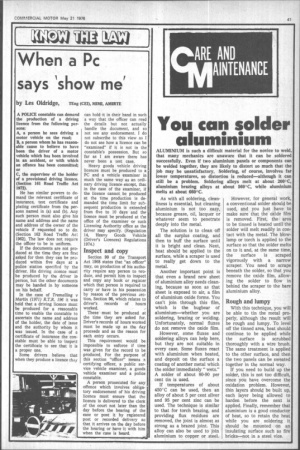You can solder aluminium
Page 45

If you've noticed an error in this article please click here to report it so we can fix it.
ALUMINIUM is such a difficult material for the novice to weld, that many mechanics are unaware that it can be soldered successfully. Even if two aluminitun panels or components can be welded together, they are likely to distort so much that the job may be unsatisfactory. Soldering, of course, involves far lower temperatures, so distortion is reduced—although it can still be a problem. Soldering alloys melt at about 200°C, aluminium brazing alloys at about 560-)C, while aluminium melts at about 660°C.
As with all soldering, cleanliness is essential, but cleaning aluminium is not too easy, because grease, oil, lacquer or whatever seem to penetrate deeply into the metal.
The solution is to clean off all the surplus coating, and then to buff the surface until it is bright and clean. Next, heat should be applied to the surface, while a scraper is used to really get down to the metal.
Another important point is that even a brand new sheet of aluminium alloy needs cleaning, because as soon as that sheet is exposed to air, a film of aluminium oxide forms. You can't join through this film, which is the bugbear of aluminium—whether you are soldering, brazing or welding. Unfortunately, normal fluxes do not remove the oxide film.
However, some fluxes and soldering alloys can help here, but they are not suitable in every case. Some fluxes react with aluminium when heated, and deposit on the surface a coating of another metal which the solder immediately "wets." A solder of about 80-90 per cent tin is used.
If temperatures of about 450'C can be used, then an alloy of about 5 per cent silver and 95 per cent zinc can be used. The technique is similar to that for torch brazing, and providing flux residues are removed, the joint is almost as strong as a brazed joint. This alloy can also be used to join aluminium to copper or steel. However, for general work, a conventional solder should be used, and you just have to make sure that the oxide film is removed. First, the area to be tinned is heated until the solder will melt readily in contact with the metal. The blowlamp or torch is applied to the surface so that the solder melts on to it and, at the same time, the surface is scraped vigorously with a narrow scraper. You need to scrape beneath the solder, so that you remove the oxide film, allowing the solder to flow in behind the scraper to the bare aluminium alloy.
Rough and lumpy
With this technique, you will be able to tin the metal properly, although the result will be rough and lumpy. To level off the tinned area, heat should continue to be applied while the surface is scrubbed thoroughly with a wire brush. The same treatment is applied to the other surface, and then the two panels can be sweated together in the normal way.
If you need to build up the solder, this is not too difficult, since you have overcome the oxidation problem. However, thin layers should be built up, each layer being allowed to harden before the next is applied. Finally, remember that aluminium is a good conductor of heat, so to retain the heat while you are soldering it should be mounted on an insulating surface such as fire bricks—not in a steel vice.
































































































